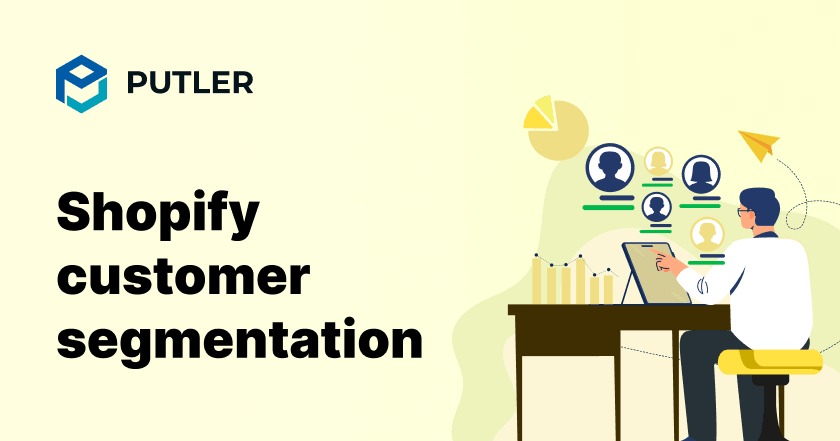Imagine you are planning to sell American flag t-shirts before the 4th of July. Is it smart to promote it to French customers?
No, right? You will choose a customer group from America. This process of grouping customers based on different characteristics is called customer segmentation.
Now, how do you collect data to create these groups? The typical way would be through sign-up forms, surveys, etc.
However, the process of collecting this data directly from your Shopify store is called Shopify customer segmentation.
Let’s understand this in detail.
What is Shopify Customer Segmentation?
Shopify customer segmentation involves dividing customers into groups based on specific characteristics or behaviors.
These customer segments can be used for targeted marketing, sales, and product offerings.
You can choose to opt for predefined primary segments or choose to create highly targeted customer segments.
For example, a jewelry store owner creates segments like “High-spender fashionistas”.
This segment includes trend-conscious customers who spend a lot on the latest trending jewelry.
The store owner can now use this segment to promote highly-priced trendy jewelry for maximum sales.
You see, it’s no rocket science.
Now, let’s dig deeper into the types of customer segmentation.
What are the types of customer segmentation?
The four main customer segment types are demographic, geographic, psychographic, and behavioral.
Let’s take a closer look at each one.
Demographic
Demography means the study of the population.
Segmenting the population by age, gender, income, occupation, and education level is referred to as demographic customer segmentation.
For example, you want to market high-end products to high-income customers.
Geographic
This method of segmenting customers groups them by location, region, city, country, etc.
This is often useful if you have brick-and-mortar stores or offer local delivery.
You can customize site content, run location-based promotions, or open stores where demand is highest.
For example, if you have a multilingual audience, your site can render content in the native language of your reader.
Psychographic
This is segmented by lifestyle, values, interests, hobbies, and personality.
You can gather psychographic data through surveys and social media.
This data lets you tailor messaging to connect with different customer mindsets.
For example, promoting eco-friendly products to environmentally-conscious shoppers.
Behavioral
Behavioral customer segmentation groups customers by their buying behaviors, shopping habits, frequency of purchase, products they’re interested in, and more.
Analyzing purchase history and on-site behavior helps you predict what customers might buy next and target them with personalized offers.
For example, reaching out to loyal or big-spending customers with VIP perks.
For more information check out this quick customer segmentation guide.
Now you know what Shopify customer segmentation is.
But why does it really matter? Let’s find out.
What are the benefits of Shopify customer segmentation?
Shopify offers in-built customer segmentation analysis for store owners. This has plenty of benefits.
Let’s discuss the major ones.
Improved marketing efficiency
If you precisely identify your target audience, your marketing efficiency will improve exponentially for two reasons –
- They’re more likely to buy what you’re offering.
- It saves plenty of time, money, energy, and resources.
-
And, that further helps you get more conversions and improve overall sales.
Strong customer relationships
Shopify customer segmentation also helps you understand their spending habits, interests, location, and more.
It allows you to use personalized marketing messages and channels of communication.
Such an approach gives them the impression that you understand what they want, you care about their needs, and it’s easier to buy from you.
This helps build trust, leading to stronger customer relationships.
Identification of upselling and cross-selling opportunities
By analyzing your customers’ purchase histories and behaviors, you can identify opportunities to sell additional or related products.
For example, if a customer frequently buys T-shirts, you might suggest shorts or jeans to match.
Also if they buy a beginner model of a product, suggest an upgrade to an intermediate model.
Look for items that complement each other or the ones that customers often buy together.
Re-engage customers
Through Shopify customer segmentation, you can identify customers at risk of churn or inactive for a long period.
Figure out their interests and preferences, then reach out with personalized messages.
Run a personalized re-engagement campaign, give special discounts, and send interesting content.
Target purchase behavior
For frequent shoppers, send exclusive offers and discounts to show them you appreciate their business.
Occasional customers may need reminders about your store to spur another purchase, so retarget them across social media and via email newsletters.
First-time buyers should receive a welcome email soon after their purchase, thanking them and encouraging another visit.
You might offer them a coupon for their next order.
Target a specific location
As a Shopify merchant, you have access to data on where your customers are located.
Look at the locations where you have the highest number of customers and sales.
These spots should be your top priorities for location-based marketing.
You can also use services like Facebook Ads and Google Ads to target users by location.
Engage high-value customers
It’s also important to understand your high-value customers’ purchasing behaviors and preferences.
Maybe they tend to buy certain types of products or shop more frequently during certain times of the year. Use this insight to tailor your marketing and promotions specifically to them.
For example, you might create a VIP program that provides special discounts, early access to new products, or free shipping on all orders.
Sending personalized emails highlighting their favorite products or suggestions based on their past purchases is another way to nurture the relationship.
Engage first-time customers
When new customers discover your store for the first time, roll out the red carpet for them.
Prominently feature your top products or best deals on your homepage to give them an instant taste of what you offer.
You might create a special “Welcome” offer for first-timers to make their first purchase even sweeter.
Send a personalized “Thank you for shopping with us!” email after they buy to make them feel appreciated.
Now, you might be wondering, how exactly can you create a customer segment in Shopify to reap all these benefits.
Well, get set for the simplest method to make Shopify customer segmentation work for you.
Let’s walk you through it step by step.
How do I create a customer segment in Shopify?
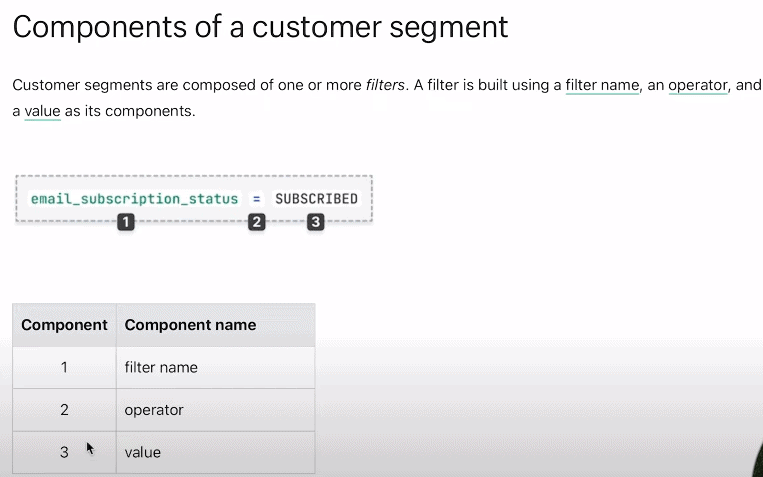
A customer segment is created using three elements: filter name (e.g. cities, purchased products, number of orders), operator (e.g. <, =, >), and value (e.g. 300, 400).
Identify Your filters
The first step is determining how you want to slice and dice your customer base.
Choose 2-3 filters to focus on for your first Shopify customer segments. You can always refine and adjust over time.
Create Your Segments
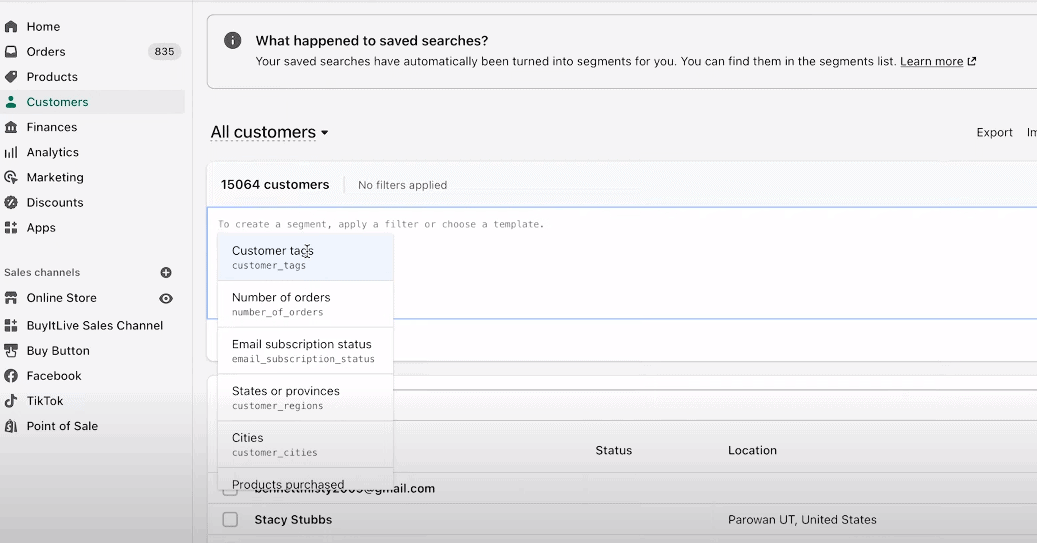
To set up Shopify customer segmentation, follow these steps:
- Go to “Customers” and find the “Segment editor” at the top.
- Click “Create segment” and pick your filters. For instance, you might want customers with over 300 orders.
- Choose the filter “Number of orders,” set the operator to “more than,” and input the value “300.” It’ll appear as “Number of orders > 300.”
- Give your segment a name and save it.
Shopify will gather Shopify customer data, and show who has made over 300 orders, allowing you to tailor campaigns specifically to them.
Top 3 customer segmentation tools: How do they work?
Now using Shopify customer segmentation can be complex, especially for those who are new to it.
The built-in customer segmentation tool may not spot all the customer behavior types and preferences essential for a Shopify merchant.
Also, there is a risk of creating too many segments, leading to inefficiencies.
The best suggestion will be to use customer segmentation tools.
Kissmetrics
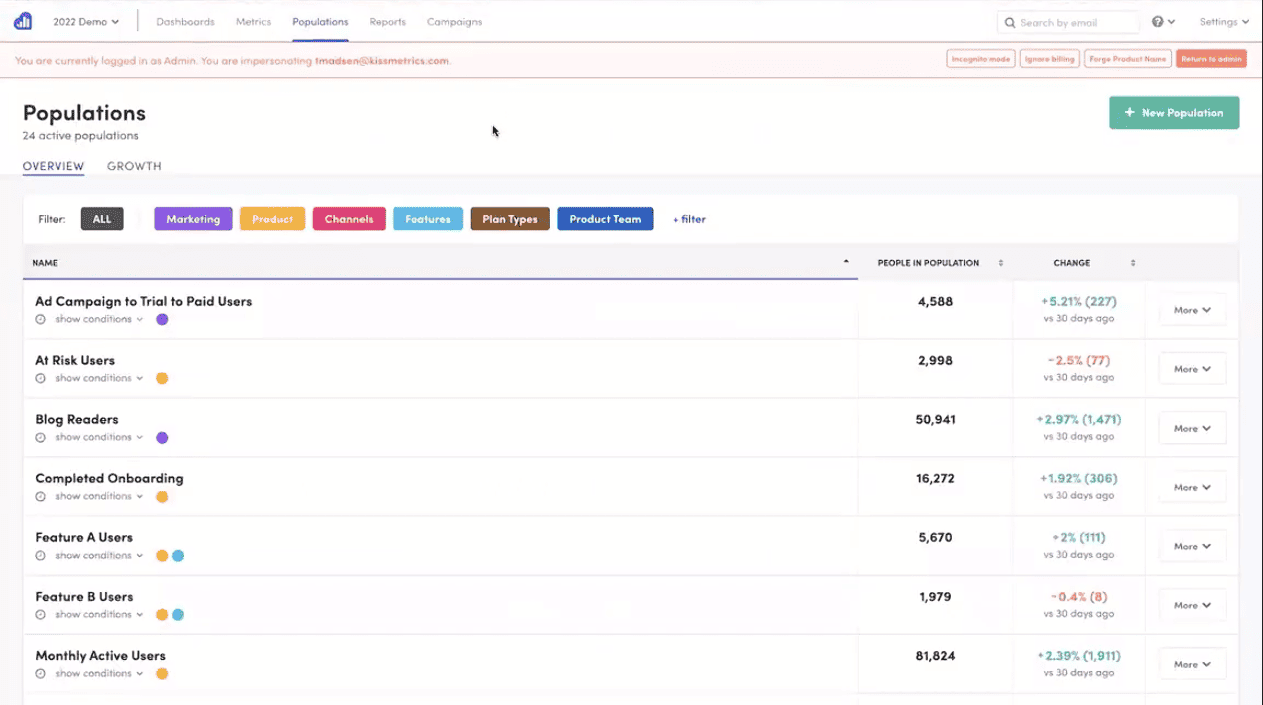
Kissmetrics is a customer analytics tool that helps you with customer segmentation.
You can see under the “Population” tab there are pre-build customer segmentations – paid users, at-risk users, only blog readers, feature A/B users, monthly active users, etc.
For example, if you wanted to know customers at risk, you can add conditions to this segment like not logged in 4 months.
This will provide you with a list of people that meet all the conditions.
You can see further segmentation in reports based on countries, cities, channels, etc.
You can also see the campaigns that they have joined from like social media, email, blog posts, and paid campaigns.
So you can see which campaign is working better for you.
Price: $199/month
Putler
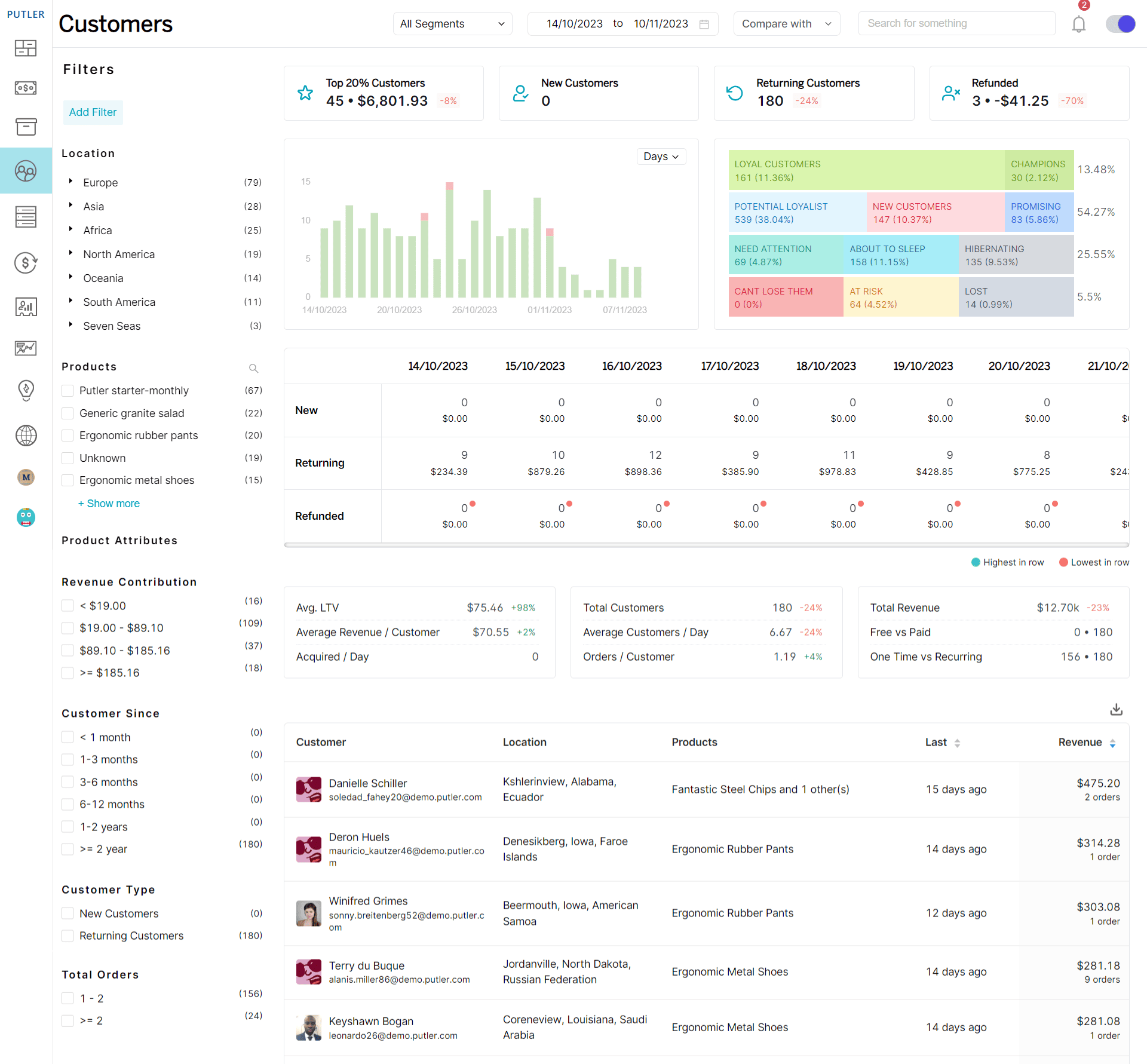
If you want an analytics tool with easy but powerful customer segmentation, Putler is a great choice.
Putler is an analytics tool for eCommerce and SaaS businesses.
It gives you in-depth customer insights even at the particular customer level. Simply integrate Putler with your Shopify store, and the magic begins.
You can use different filters to segment customers such as location, products, product attribute, revenue contribution, customer type, customer since, or number of orders.
For example, customers from the USA who spent more than $100 or new customers from the USA.
In just a few clicks you have the list of customers that fall under your criteria. You can also add custom filters by defining conditions.
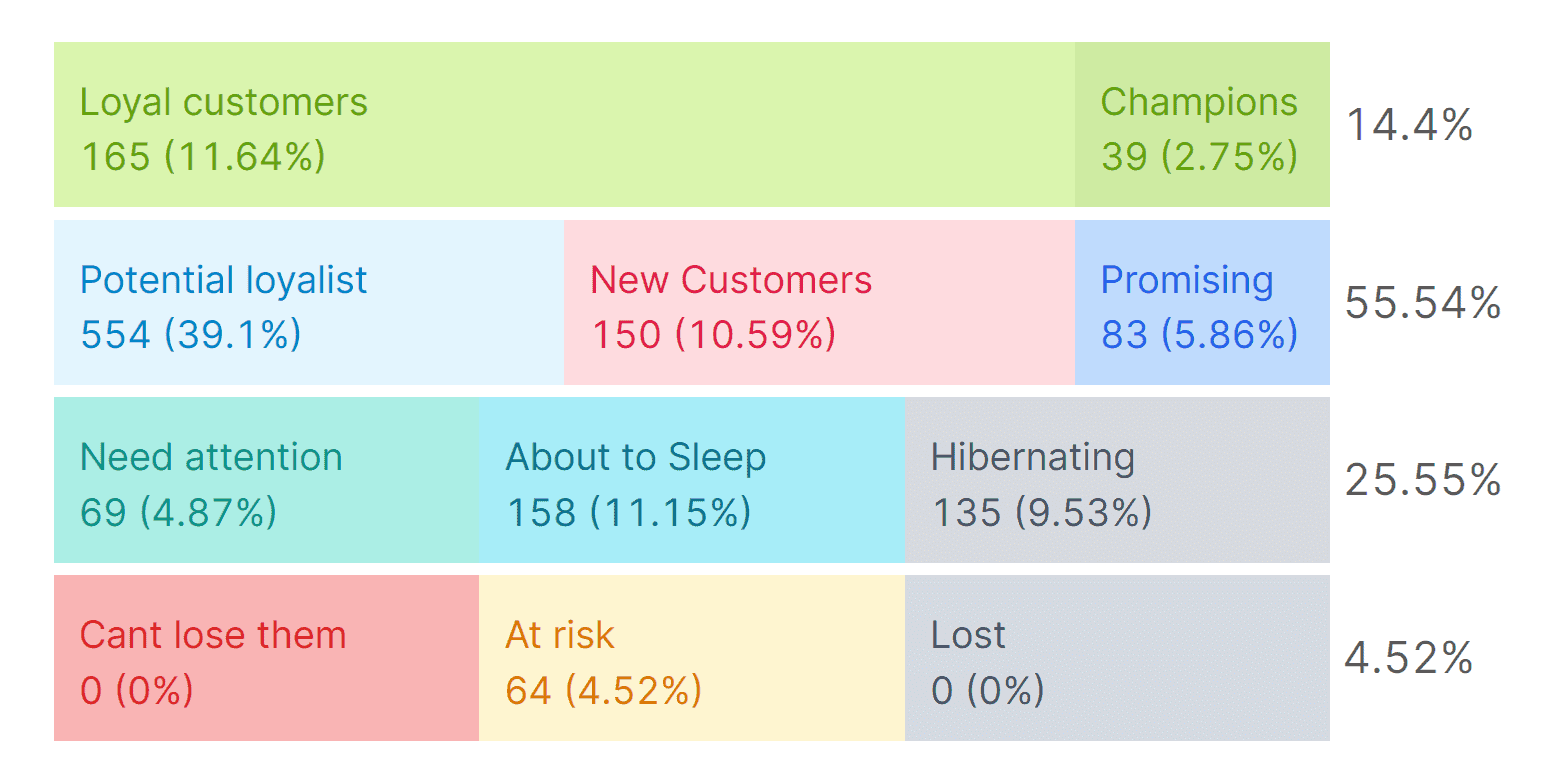
Putler also offers RFM customer segmentation. RFM analysis, based on recency, frequency, and monetary factors, effectively segments customers by their behavior.
RFM covers everything from champion customers to customers at risk.
You can quickly identify essential segments, whether they are potential loyalists, new customers, or those needing immediate attention.
FYI, Not just customer segmentation, Putler provides filters to segment other aspects of your store as well – like product segmentation, order segmentation, and a lot more.
Price: $20/ month onwards
Segment
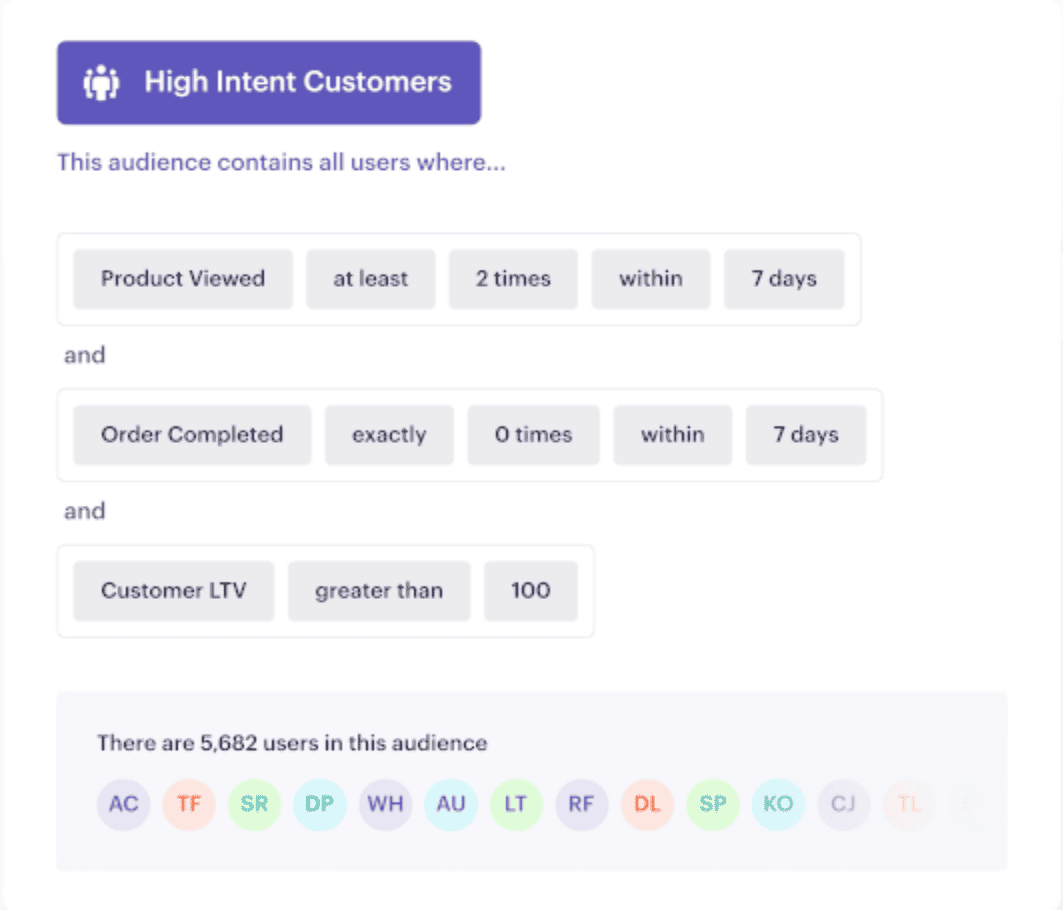
Twilio Segment is a powerful tool that helps you collect, unify, and analyze customer data from different sources.
Here’s how you can use it for customer segmentation in your Shopify store.
Integrate Twilio Segment with your Shopify store to gather data from various touch points like website visits, purchases, abandoned carts, and more.
Decide what factors matter most, like purchase frequency or location. Use Segment’s tools to group customers based on your chosen criteria.
Once segmented, send targeted emails or messages tailored to each group.
Price: $120/ month
Take your marketing to the next level with Shopify’s customer segmentation
With a bit of focus, you can take your marketing to the next level through Shopify customer segmentation.
Start by identifying your goal – do you want to target new customers, encourage repeat purchases, or build loyalty?
Once you’ve set your goal, use Putler’s customer segmentation and 200+ metrics to gain insights into sales, customers, products, and orders.
So don’t be intimidated, start segmenting your customers and soon you’ll be engaging customers like never before.
